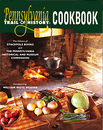Pennsylvania Dutch Tradition
This article originally appeared in Pennsylvania Trail of History Cookbook
About 75,000 German-speaking immigrants accepted William Penn's invitation to come to Pennsylvania between 1683 and 1820. Leaving behind religious persecution and economic hardship, they found some of the richest farming soil in the New World in southeastern Pennsylvania. By 1790, the Pennsylvania "Dutch" made up about 40 percent of the state's population, many of them living in Berks and Lancaster Counties. The Landis Valley Museum in Lancaster County, the largest museum of Pennsylvania Dutch life in the country, showcases and interprets their culture, including their foodways.
The Pennsylvania Dutch have made significant contributions to food traditions in Pennsylvania and across America. Traditional Pennsylvania Dutch cooking features the interplay between sweet and salty flavors, such as in schnitz un knepp * and gumbis *, and between sweets and sours. Many food dishes that remain popular to this day are associated with the Pennsylvania Dutch, including pretzels, sauerkraut, fasnachts, liverwurst, scrapple *, and dandelion salad.
Fermented cabbage, known as sauerkraut *, was enjoyed throughout the year and is still traditionally served with pork on New Year's Day to ensure good luck in the coming year. When the Confederate Army captured the town of Chambersburg in 1863, they demanded twenty-five barrels of sauerkraut from the town's residents. The town's leaders thought it was a trick until they realized the Rebel soldiers were suffering from scurvy, for which sauerkraut offered nutritional relief.
Fasnachts (a potato-based doughnut) are prepared on Shrove Tuesday, often referred to as Fasnacht Day. They represent a last-minute indulgence before the austerity of the Lenten season, as well as a way of using up the lard in the house.
Pennsylvania Dutch cooking, with its roots in Pennsylvania's past, has become a significant part of modern cuisine.
* Recipes for these Pennsylvania Dutch dishes are available in the Pennsylvania Trail of History Cookbook
Visit
Landis Valley Village and Farm Museum, Lancaster, PA
Step into the largest museum of early Pennsylvania German life in the country.
For Further Reading
 |
Pennsylvania Trail of History Cookbook Edited by Kyle R. Weaver, Diane B. Reed, and Fred Lauver Forward by William Woys Weaver Stackpole Books and Pennsylvania Historical and Museum Commission 2004 |
 |
Landis Valley Museum: Pennsylvania Trail of History Guide by Elizabeth Johnson Stackpole Books and Pennsylvania Historical and Museum Commission 2002 |


